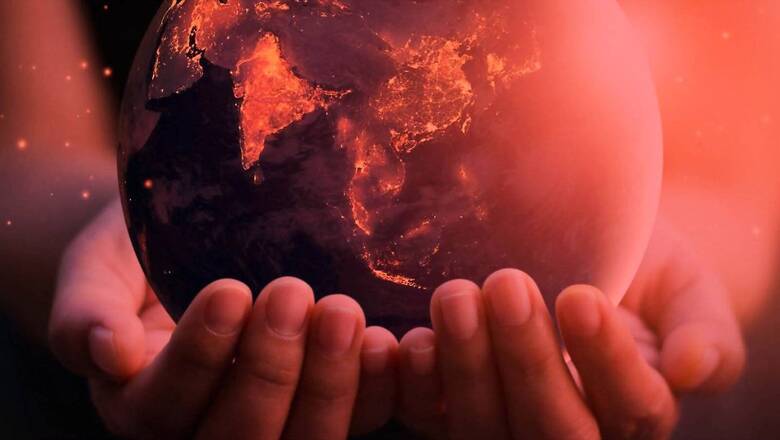
views
The Intergovernmental Panel on Climate Change (IPCC) released its Sixth Assessment Report (AR6) recently. Three years of work by over 230 scientists from across the world, assessing more than 14,000 scientific publications on the subject of climate change, has resulted in the strongest and clearest report to date from the IPCC which shared the Nobel Peace Prize with Al Gore in 2007.
Daily headlines over the past weeks and months are filled with reports of the latest weather disaster—be it floods during the monsoon season or heat waves and wildfires from across the world. These extreme events are some of the ways in which climate change manifests itself and this report provides a punctuation mark by putting them in the climate change context. The new report states unequivocally that the human influence on climate is already influencing many weather and climate extremes in every region across the globe. Climate change has led to other widespread and rapid changes in the last few decades with the scale of recent changes unprecedented over thousands of years. There is no going back on some of these effects—such as melting glaciers and the ice sheets of Greenland and Antarctica and the resulting sea level rise—and these will continue for centuries.
Shape of Things to Come
In our own region, the Indian Ocean is witnessing the fastest rate of warming and sea level rise globally with grave consequences for coastal flooding and the added threat of stronger tropical cyclones. The monsoon rainfall that our country critically depends on has been adversely affected by the greenhouse gases and polluting particles that are emitted by burning fossil fuels. The frequency and intensity of hot extremes as well as heavy rainfall events have increased as a consequence of warming.
As we emit more of the heat-trapping greenhouse gases, we will experience more warming, and the changes we experience will increase as a consequence. The monsoons are expected to become more intense but also more variable leading to increased severity of wet and dry events. Snow-covered areas and snow volumes will decrease, and glaciers will lose mass. Rising temperature and rainfall can increase the occurrence of glacial lake outburst, floods and landslides over the Himalayas—predictions that have become reality of late. However, some changes could be slowed, and others could be stopped by limiting warming—through strong, rapid, and sustained reductions in CO2, methane, and other greenhouse gases.
What are the Adaptation Implications
That weather and climate extremes will become more widespread, frequent and intense as the climate warms is a call for action. If we as a society have to live with the changes that have already occurred and will occur in the future, we will have to build strategies for adaptation. Current ways of dealing with extreme weather and climate events are still focused more on the short-term with early warning systems prior to a disaster followed by post-disaster management.
This has inherent limitations when it comes to the increasing hazards that we are facing as a result of continued global warming. First, the prediction of a cyclone or some weather event is very different from predicting the full impacts of the storm surge, the rainfall and stream flows that compound the impacts of such events. Understanding and predicting how these effects interact with the built infrastructure and the human dimension is an even harder problem and still at a nascent stage even in the most advanced countries. To plan for increasing frequencies and magnitudes of disasters will require policymakers to first recognise and then invest in comprehensive systems that are aimed at managing the risk to society.
Second, the costs of repeated disasters (in terms of lives, livelihoods, infrastructure and economic impact) need to be better represented in our calculations of the true cost of climate change and any actions we may take to mitigate climate change. Without better analysis and decision support systems, the job of policy makers is not only going to get harder but will potentially be crippled by inadequate information.
The report has guidance on how usable information can be derived at regional and local scales and how climate services can be developed to aid policy and action. A handy feature of the current report is also a dynamic online Atlas that allows people to visualise observed and modelled data from specific regions of interest, and use these to quickly perform relevant analysis.
What are the Response Implications
The only solution to stop or even reduce further climate change is to stop adding carbon dioxide and other greenhouse gases to the atmosphere. This report makes it clear that our chances of meeting the Paris Accord aspiration of keeping global temperature change to under 1.5 degrees Celsius are reducing fast and immediate and rapid reductions in emissions are required to meet the goal.
While nations negotiate on further cuts to emissions, current national commitments by countries around the world put us on track to exceed 2 degrees warming by a wide margin. Commitments that include using natural sinks such as land and ocean will need to be re-examined in light of new findings that as our emissions increase, these natural sinks become less efficient at soaking up carbon. The role of short-lived climate forcers such as aerosols that make for poor air quality, methane and other greenhouse gases are of key relevance to our region where they currently have a fairly large effect on our temperatures and rainfall. These are also co-emitted by the same human activities that release carbon dioxide, and a more comprehensive look at how we might commit to reducing these emissions and benefit from better air quality is required.
While the effects of reducing the short-lived climate forcers will be quickly seen, over the long-term, carbon dioxide additions to the atmosphere have to get to zero. How we get there should be the focus internationally. How soon can we afford to do it might be a subject of international negotiation, but climate change knows no political boundaries. The necessity to act immediately and reduce emissions sharply requires the richer nations with better resources to step in and take the lead. This does not absolve us as a nation or individuals from doing much more than we already do. The message on what is already occurring, what will get worse and what to do about it cannot be more clearly presented. It is up to us to act now.
The author is Professor and Head, Centre for Atmospheric Sciences, Affiliate Faculty, School of Public Policy, Indian Institute of Technology, Delhi. He has also contributed to the IPCC report. The views expressed in this article are those of the author and do not represent the stand of this publication.
Read all the Latest News , Breaking News and IPL 2022 Live Updates here.
















Comments
0 comment